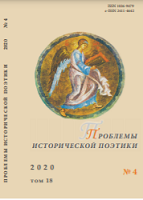Le Bourgeois gentilhomme в романе Л. Н. Толстого «Война и мир»
Le Bourgeois Gentilhomme in Leo Tolstoy’s Novel War and Peace
Author(s): Mikhail V. StroganovSubject(s): Studies of Literature, Social history, Russian Literature, 18th Century, 19th Century
Published by: Петрозаводский государственный университет
Keywords: Leo Tolstoy; War and Peace; Moliere; the French revolution; Napoleon; reminiscence; image; motif;
Summary/Abstract: L. N. Tolstoy does not make any direct statements about the great French Revolution, although a probe into the writer’s attitude to this historical event allows us to understand his interpretation of phenomena contemporary to him. In this sense, the analysis of the early drafts of the novel War and Peace (1864) conducted in this article is of great interest. In these drafts, French politicians of the Directory period are called ‘rich upstarts’ and ‘yesterday’s bourgeois gentilhommes.’ Bonaparte himself is referred to as “a clever, cunning and evil successful bourgeois.” And in the outline of the preface to the novel Tolstoy repeats this comparison again: “funny and disgusting, like a Philistine in the nobility.” All of these formulas date back to the famous comedy by J. B. Moliere Le Bourgeois Gentilhomme (1670). Although Napoleon Bonaparte was not a bourgeois by birth, his origins in the provincial Corsica led to a mention of him as a “bourgeois nobleman,” or parvenu in the drafts of War and Peace. This expression had a negative connotation due to the hereditary pride and prejudice of the aristocrat Tolstoy against the lower classes and his reaction to the novel by N. G. Chernyshevsky’s What Is to Be Done? (1863). In the final text of War and Peace, influenced by the news of the civil execution and exile of Chernyshevsky, Tolstoy removed these direct characteristics, although the overall negative assessment of Napoleon remained. Later Tolstoy repeatedly used images of this comedy, but did not attach negative connotations to them. Establishing the connection between the image of Napoleon and the “bourgeois gentilhommes” in the drafts for Tolstoy’s novel War and Peace allows us to more accurately determine the writer’s political views in the mid-1860s.
Journal: Проблемы исторической поэтики
- Issue Year: 18/2020
- Issue No: 4
- Page Range: 248-262
- Page Count: 15
- Language: Russian

